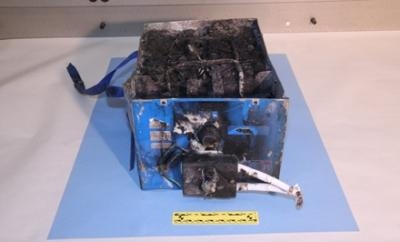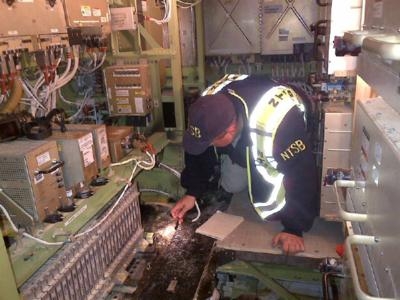Fri, Jan 18, 2013
Two Recent Incidents Now Appear Different In Nature
Quoting sources that would speak only on the condition of anonymity, the Seattle Times is reporting that hot chemicals sprayed out of the battery on the 787 Dreamliner that made an emergency landing in Japan on Wednesday. The result was a gooey dark residue left behind that suggests a different malfunction than last week's battery fire in a 787 at Boston's Logan International Airport.

While there was no fire in the most recent incident one of the Times' sources said "It's still a problem. There was significant overheating."
The more significant problem may become the emerging reports that Boeing was warned about the safety of the batteries and associated systems as early as 2006. Those reports center on the actions of whistleblower Michael Leon.
Aviation reporter and blogger Ben Sandilands writes in Plane Talking that while employed at Securaplane, which brought together mission critical battery assemblies for the 787, Leon wrote a report on the battery technology planned for the 787 saying it was a flight of safety risk and that substitute battery technology should be used. A month later, Securaplane's main buildings were burned to the ground when a battery test went wrong. Leon was injured in the blaze. Securaplane reportedly tried to force Leon out of the company when he refused to ship what he considered an unsafe battery assembly to Boeing for use in the 787. That assembly later malfunctioned when installed in a prototype airframe.
There are four circuits that control the batteries in question, two within the battery and two external. Boeing says it believes those circuits performed as designed and stopped the overheating before any fire could start. Additionally Boeing says tests show that any smoke from the incident should have vented overboard through outflow valves and not entered either the passenger cabin or cockpit. But ANA (All Nippon Airways) said its pilots did smell something they thought was smoke and that the smell was also in the passenger cabin. The FAA, in announcing its decision to ground the fleet said in its statement that both battery incidents resulted in the "release of flammable electrolytes, heat damage, and smoke."

It was that smell and warnings of battery trouble on the instrument panel that compelled the ANA pilot to execute the emergency landing and deploy the emergency exit chutes to evacuate the 137 passengers and crew.
The Times reports that two people with knowledge of the incident said the pilot received three battery warnings, including one that said the battery was overheating.
The 787s batteries are made by GS Yuasa of Japan and its manufacturing process is almost certainly gong to become part of the investigation.
(Images provided by the NTSB)
More News
Decision Altitude (DA) A specified altitude (mean sea level (MSL)) on an instrument approach procedure (ILS, GLS, vertically guided RNAV) at which the pilot must decide whether to >[...]
Aero Linx: T-34 Association, Inc. The T-34 Association was formed in July 1975 so that individuals purchasing then military surplus T-34As had an organization which would provide s>[...]
As He Released The Brakes To Begin Taxiing, The Brake Pedals Went To The Floor With No Braking Action Analysis: The pilot reported that during engine start up, he applied the brake>[...]
“Legislation like the Mental Health in Aviation Act is still imperative to hold the FAA accountable for the changes they clearly acknowledge need to be made... We cannot wait>[...]
Also: IAE Acquires Diamond Trainers, Army Drones, FedEx Pilots Warning, DA62 MPP To Dresden Tech Uni The danger to the flight training industry and our future pilots is clear. Dona>[...]
 ANN's Daily Aero-Term (12.08.25): Decision Altitude (DA)
ANN's Daily Aero-Term (12.08.25): Decision Altitude (DA) ANN's Daily Aero-Linx (12.08.25)
ANN's Daily Aero-Linx (12.08.25) NTSB Final Report: Piper PA-31T3
NTSB Final Report: Piper PA-31T3 Aero-News: Quote of the Day (12.08.25)
Aero-News: Quote of the Day (12.08.25) Airborne-Flight Training 12.04.25: Ldg Fee Danger, Av Mental Health, PC-7 MKX
Airborne-Flight Training 12.04.25: Ldg Fee Danger, Av Mental Health, PC-7 MKX




